NCERT Solution Class 10 Maths Chapter 10: CirclesExercise 10.11. How many tangents can a circle have? Solution A circle consists of infinite number of points equidistant from its centre. Since the number of points are infinite, therefore, the number of tangents through those points will also be infinite. Hence, a circle has infinite tangents. 2. Fill in the blanks :
Solution
3. A tangent PQ at a point P of a circle of radius 5 cm meets a line through the centre O at a point Q so that OQ = 12 cm. Length PQ is : (A) 12 cm (B) 13 cm (C) 8.5 cm (D) √119 cm. Solution 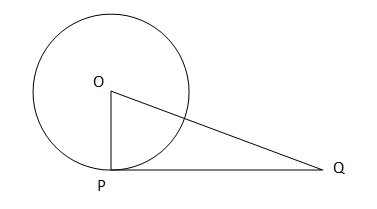
Upon drawing the figure, it can be observed that OP is perpendicular to PQ and PQ is a tangent. By using Pythagoras Theorem in POQ, we get OQ2 = OP2 + PQ2 122 = 52 + PQ2 144 = 25 + PQ2 PQ2 = 119 PQ = √119 cm Hence, (D) is the correct answer. 4. Draw a circle and two lines parallel to a given line such that one is a tangent and the other, a secant to the circle. Solution 
Exercise 10.2In Q.1 to 3, choose the correct option and give justification. 1. From a point Q, the length of the tangent to a circle is 24 cm and the distance of Q from the centre is 25 cm. The radius of the circle is (A) 7 cm (B) 12 cm (C) 15 cm (D) 24.5 cm Solution 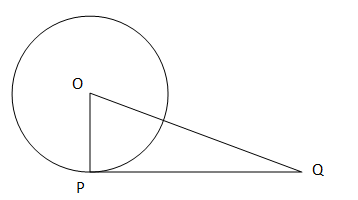
Let the point at which the tangent meets the circle be P. POQ will form a right triangle as the tangent to a circle is perpendicular to the radius that intersects with them. By using Pythagoras Theorem in POQ, we get OQ2 = OP2 + PQ2 (25)2 = OP2 + (24)2 OP2 = 625 - 576 OP2 = 49 OP = 7 cm Hence, (A) is the correct option. 2. In Fig. 10.11, if TP and TQ are the two tangents to a circle with centre O so that ∠ POQ = 110°, then ∠ PTQ is equal to (A) 60° (B) 70° (C) 80° (D) 90° 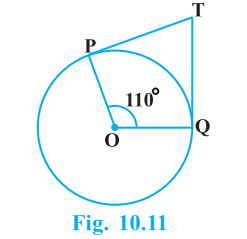
Solution Since PT and QT are tangents and OP and OQ are radii of the circle. Therefore ∠OPT = ∠OQT = 90° as the tangent to a circle is perpendicular to the radius that intersects with them. POQT is a quadrilateral. Therefore, ∠OPT + ∠OQT + ∠POQ + ∠PTQ = 360° 90° + 90° + 110° + ∠PTQ = 360° 290° + ∠PTQ = 360° ∠PTQ = 70° Hence, (B) is the correct answer. 3. If tangents PA and PB from a point P to a circle with centre O are inclined to each other at angle of 80°, then ∠ POA is equal to (A) 50° (B) 60° (C) 70° (D) 80° Solution 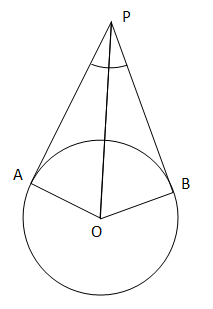
Since PB and PA are tangents and OA and OB are radii of the circle. Therefore ∠OAP = ∠OBP = 90° as the tangent to a circle is perpendicular to the radius that intersects with them. POQT is a quadrilateral. Therefore, ∠OAP + ∠OBP + ∠AOB + ∠APB = 360° 90° + 90° + 80° + ∠AOB = 360° 260° + ∠AOB = 360° ∠AOB = 100° In OAP and OBP: AP = BP (Since the tangents from a point are always equal) OA = OB (Radii of the circle) OP = OP (Common side) Therefore, by the SSS congruency criterion ?OPB ≅ ?OPA. By c.p.c.t., ∠POB = ∠POA ∠AOB = ∠POA+∠POB 2 (∠POA) = ∠AOB ∠POA = ∠AOB/2 ∠POA = 100°/2 = 50° Hence, (A) is the correct answer. 4. Prove that the tangents drawn at the ends of a diameter of a circle are parallel. Solution 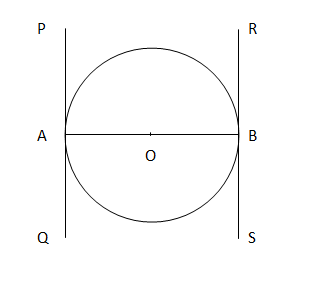
Let there be a circle with centre O and diameter AB. The end-points of the diameter meet tangents PQ and RS respectively. Since, OA and OB are radii of the circle. Therefore, OA and OB will be perpendicular to PQ and RS respectively. ∠OBR = ∠OAQ and ∠OBS = ∠OAP (Each 90°) Since the alternate interior angles are equal. Therefore, PQ and RS are parallel to each other. Hence, proved. 5. Prove that the perpendicular at the point of contact to the tangent to a circle passes through the centre. Solution 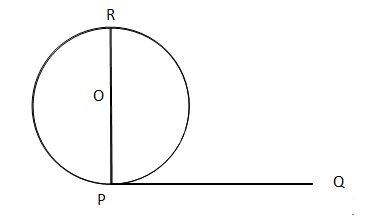
Let there be a circle with centre O. Draw a tangent PQ to a point P on the circle. Now draw RP which is perpendicular to PQ. Since, P lies on the circle. Therefore, there will be a radius OP of the circle. We know that radius of a circle is perpendicular to the tangent at its point of contact. Thus, ∠OPQ = 90° Also, ∠RPQ = 90° as RP is perpendicular to PQ. This is only possible if OP lies on RP. Hence, the perpendicular at the point of contact to the tangent to a circle passes through the centre. 6. The length of a tangent from a point A at distance 5 cm from the centre of the circle is 4 cm. Find the radius of the circle. Solution 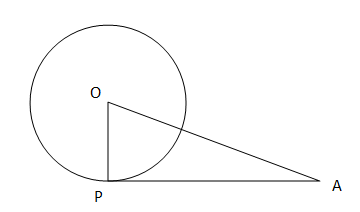
Let the centre of the required circle be denoted by O. Let OP be the radius and AP be the tangent. We know that the radius of a circle is perpendicular to the tangent at the point of contact. Therefore, OPA is a right triangle. By using Pythagoras Theorem in OPA, we get OA2 = OP2 + AP2 52 = OP2 + 42 25 = OP2 + 16 OP2 = 9 OP = 3 cm Hence, the radius of the circle is 3 cm. 7. Two concentric circles are of radii 5 cm and 3 cm. Find the length of the chord of the larger circle which touches the smaller circle. Solution 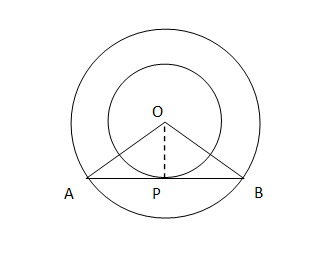
Let the two circles have the common centre O. Let AB be the chord of the bigger circle which touches the smaller circle at point P. AB is a tangent to the smaller circle, therefore, OP will be perpendicular to AB. By using Pythagoras Theorem in OPA, we get OA2 = OP2 + AP2 52 = 42 + AP2 AP2 = 25 - 16 AP2 = 9 AP = 3 cm By using Pythagoras Theorem in OPB, we get OB2 = OP2 + BP2 52 = 42 + BP2 BP2 = 25 - 16 BP2 = 9 BP = 3 cm AB = AP + BP = 3 + 3 = 6. Hence, the length of the required chord is 6 cm. 8. A quadrilateral ABCD is drawn to circumscribe a circle (see Fig. 10.12). Prove that AB + CD = AD + BC. 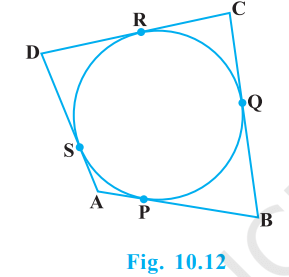
Solution We know that the lengths of tangents to a circle from an external point are equal. Thus, we can say that DR = DS AP = AS BP = BQ CR = CQ Add the above relations: DR + AP + BP + CR = DS + AS + BQ + CQ AB + CD = AD + BC Hence, proved. 9. In Fig. 10.13, XY and X?Y? are two parallel tangents to a circle with centre O and another tangent AB with point of contact C intersecting XY at A and X?Y? at B. Prove that ∠ AOB = 90°. 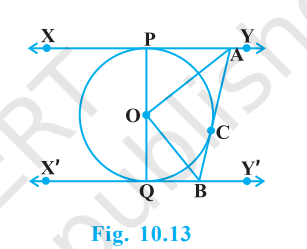
Solution We need to join OC in the given figure. 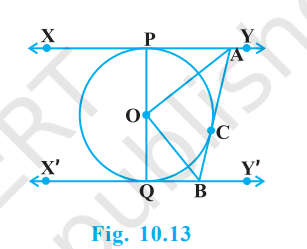
OC is the radius of the circle, while AB is the tangent to it passing through C. Therefore, OC is perpendicular to AB. Similarly OP and OQ will be perpendicular to XY and X'Y' respectively. In ?OPA and ?OCA: OP = OC (Radii of the same circle) AO = AO (Common Side) AP = AC (Tangents from an external point) Therefore, ?OPA ≅ ?OCA by the SSS congruency criterion. Similarly, we can also prove that ?OQB ≅ ?OCB. Now, by c.p.c.t., we have ∠POA = ∠COA ∠QOB = ∠COB POQ is a straight line, so ∠POA + ∠COA + ∠COB + ∠QOB = 180° 2∠COA + 2∠COB = 180° ∠COA + ∠COB = 90° ∠AOB = 90° Hence, proved. 10. Prove that the angle between the two tangents drawn from an external point to a circle is supplementary to the angle subtended by the line-segment joining the points of contact at the centre. Solution Let there be a circle with centre O with two tangents to it PA and PB from an external point P. 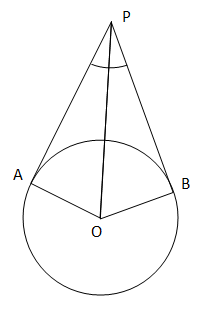
OA and OB are radii of circle that touch tangent PA and PB. Therefore, PA is perpendicular to OA and PB is perpendicular to OB. Thus, ∠OAP = 90° and ∠OBP = 90° AOBP is a quadrilateral, therefore sum of all its angles must be 360°. ∠OAP + ∠APB + ∠OBP + ∠AOB = 360° 90° + ∠APB + 90° + ∠AOB = 360° ∠APB + ∠AOB + 180° = 360° ∠APB + ∠AOB = 180° Hence, proved that the angle between the two tangents drawn from an external point to a circle is supplementary to the angle subtended by the line-segment joining the points of contact at the centre. 11. Prove that the parallelogram circumscribing a circle is a rhombus. Solution 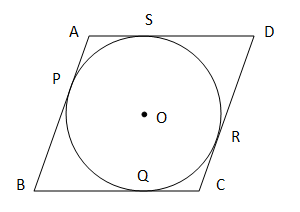
Let ABCD be a parallelogram which is circumscribing a circle having centre O. The circle comes touches the parallelogram at points P, Q, R, and S on the sides AB, BC, CD, and AD respectively. We know that tangents from an external point to a circle are equal. Therefore, AP = AS, BP = BQ, CR = CQ, DR = DS Add all the above equations: AP + BP + CR + DR = AS + BQ + CQ + DS AB + CD = AD + BC We know that opposite sides of a parallelogram are equal. Thus, AB + AB = AD + AD 2AB = 2AD AB = AD This means that CD = AB = AD = BC Since, all the sides of the parallelogram are equal. Therefore, it is a rhombus. Hence, proved. 12. A triangle ABC is drawn to circumscribe a circle of radius 4 cm such that the segments BD and DC into which BC is divided by the point of contact D are of lengths 8 cm and 6 cm respectively (see Fig. 10.14). Find the sides AB and AC. Solution 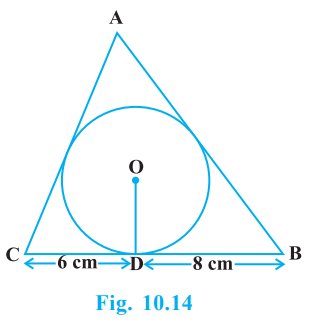
Join the points of contact of the circle and the triangle as OE and OF on sides AB and AC respectively. 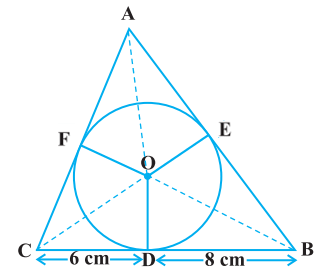
We know that tangents from an external point to a circle are equal. Therefore, CF = CD = 6 cm, AE = AF, BE = BD = 8 cm a = AB = BE + AE = 8 + AE b = BC = BD + CD = 6 + 8 = 14 cm c = AC = CF + AF = 6 + AE Semi-perimeter of the triangle ABC = s = (AB + BC + AC)/2 = (8 + AE + 14 + 6 + AE)/2 = (28 + 2AE)/2 = 14 + AE Apply the Heron's formula in ABC: Area of ABC = √s(s - a)(s - b)(s - c) = √ (14 + AE)(14 + AE - (8 + AE))(14 + AE - 14)(14 + AE - (6 + AE)) = √ (14 + AE)(14 + AE - 8 - AE)(AE)(14 + AE - 6 - AE) = √ (14 + AE)(6)(AE)(8) = √ (14 + AE)(48AE) We also know that, Area of ABC = Ar (AOF) + Ar (AOE) + Ar (BOE) + Ar (BOD) + Ar (COD) + Ar (COF) In ?AOF and ?AOE: OF = OE (Radii of the same circle) AO = AO (Common Side) AF = AE (Tangents from an external point) Therefore, ?AOF ≅ ?AOE by the SSS congruency criterion. Similarly, we can also prove that ?BOE ≅ ?BOD and ?COD ≅ ?COF. This implies thay: Area of ABC = Ar (AOF) + Ar (AOE) + Ar (BOE) + Ar (BOD) + Ar (COD) + Ar (COF) = 2 � [Ar (AOF) + Ar (BOD) + Ar (COD)] = 2 � [� (OF)(AF) + � (BD)(OD) + � (CD)(OD)] = 2 � � [4AE + 4(8) + 4(6)] = 4AE + 32 + 24 = 4AE + 56 Now, 4AE + 56 = √ (14 + AE)(48AE) Square on both sides, (4AE + 56)2 = (14 + AE)(48AE) (4(14 + AE))2 = (14 + AE)(48AE) 16(14 + AE) = 48AE 14 + AE = 3AE 14 = 2AE AE = 7 cm Hence, the side AB = 8 + 7 = 15 cm and AC = 7 + 6 = 13 cm 13. Prove that opposite sides of a quadrilateral circumscribing a circle subtend supplementary angles at the centre of the circle. Solution 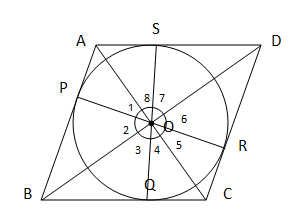
Let ABCD be a parallelogram which is circumscribing a circle having centre O. The circle comes touches the parallelogram at points P, Q, R, and S on the sides AB, BC, CD, and AD respectively. AP = AS (Tangents from an external point) OA = OA (Common side) OP = OS (Radii of the circle) So, by SSS congruency ?OAP ≅ ?OAS. This implies that, ∠1 = ∠8 (by c.p.c.t) Similarly, we can also proved that ∠4 = ∠5 ∠2 = ∠3 ∠6 = ∠7 Add all the obtained equations together: ∠1 + ∠2 + ∠3 + ∠4 + ∠5 + ∠6 + ∠7 + ∠8 = 360° 2∠1 + 2∠2 + 2∠5 + 2∠6 = 360° 2(∠1 + ∠2 + ∠5 + ∠6) = 360° ∠1 + ∠2 + ∠5 + ∠6 = 180° ∠AOB + ∠COD = 180° Similarly, it can be proven that ∠BOC + ∠AOD = 180° Hence, proved that opposite sides of a quadrilateral circumscribing a circle subtend supplementary angles at the centre of the circle.
Next TopicClass 10 Maths Chapter 11
|
 For Videos Join Our Youtube Channel: Join Now
For Videos Join Our Youtube Channel: Join Now
Feedback
- Send your Feedback to [email protected]
Help Others, Please Share









